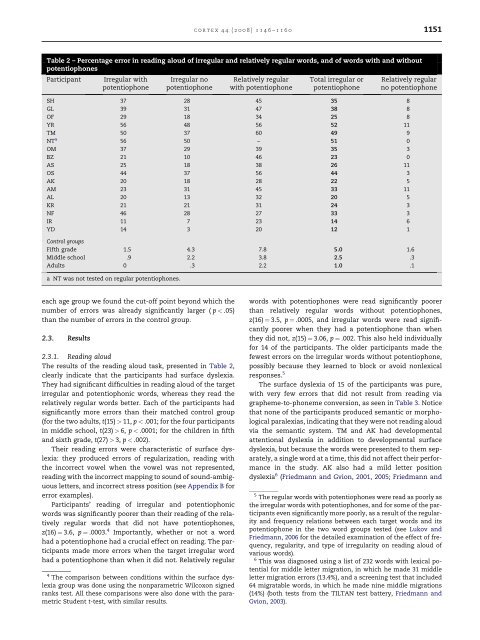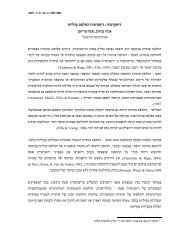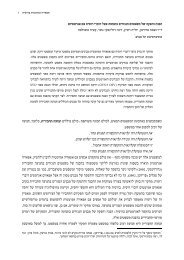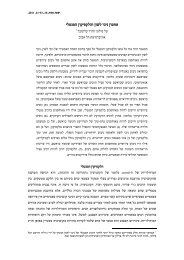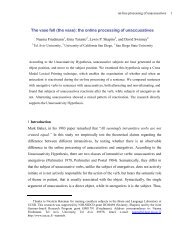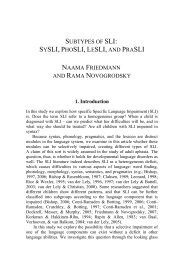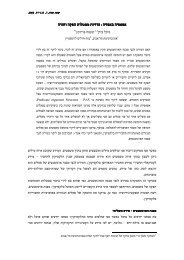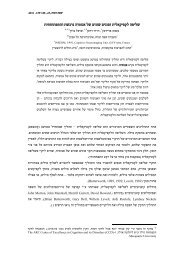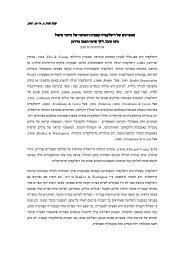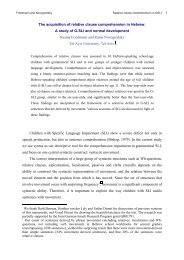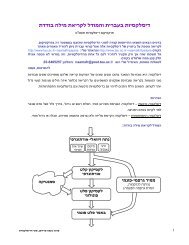Developmental surface dyslexias - Naama Friedmann
Developmental surface dyslexias - Naama Friedmann
Developmental surface dyslexias - Naama Friedmann
Create successful ePaper yourself
Turn your PDF publications into a flip-book with our unique Google optimized e-Paper software.
cortex 44 (2008) 1146–1160 1151<br />
Table 2 – Percentage error in reading aloud of irregular and relatively regular words, and of words with and without<br />
potentiophones<br />
Participant<br />
Irregular with<br />
potentiophone<br />
Irregular no<br />
potentiophone<br />
Relatively regular<br />
with potentiophone<br />
Total irregular or<br />
potentiophone<br />
Relatively regular<br />
no potentiophone<br />
SH 37 28 45 35 8<br />
GL 39 31 47 38 8<br />
OF 29 18 34 25 8<br />
YR 56 48 56 52 11<br />
TM 50 37 60 49 9<br />
NT a 56 50 – 51 0<br />
OM 37 29 39 35 3<br />
BZ 21 10 46 23 0<br />
AS 25 18 38 26 11<br />
OS 44 37 56 44 3<br />
AK 20 18 28 22 5<br />
AM 23 31 45 33 11<br />
AL 20 13 32 20 5<br />
KR 21 21 31 24 3<br />
NF 46 28 27 33 3<br />
IR 11 7 23 14 6<br />
YD 14 3 20 12 1<br />
Control groups<br />
Fifth grade 1.5 4.3 7.8 5.0 1.6<br />
Middle school .9 2.2 3.8 2.5 .3<br />
Adults 0 .3 2.2 1.0 .1<br />
a NT was not tested on regular potentiophones.<br />
each age group we found the cut-off point beyond which the<br />
number of errors was already significantly larger ( p < .05)<br />
than the number of errors in the control group.<br />
2.3. Results<br />
2.3.1. Reading aloud<br />
The results of the reading aloud task, presented in Table 2,<br />
clearly indicate that the participants had <strong>surface</strong> dyslexia.<br />
They had significant difficulties in reading aloud of the target<br />
irregular and potentiophonic words, whereas they read the<br />
relatively regular words better. Each of the participants had<br />
significantly more errors than their matched control group<br />
(for the two adults, t(15) > 11, p < .001; for the four participants<br />
in middle school, t(23) > 6, p < .0001; for the children in fifth<br />
and sixth grade, t(27) > 3, p < .002).<br />
Their reading errors were characteristic of <strong>surface</strong> dyslexia:<br />
they produced errors of regularization, reading with<br />
the incorrect vowel when the vowel was not represented,<br />
reading with the incorrect mapping to sound of sound-ambiguous<br />
letters, and incorrect stress position (see Appendix B for<br />
error examples).<br />
Participants’ reading of irregular and potentiophonic<br />
words was significantly poorer than their reading of the relatively<br />
regular words that did not have potentiophones,<br />
z(16) ¼ 3.6, p ¼ .0003. 4 Importantly, whether or not a word<br />
had a potentiophone had a crucial effect on reading. The participants<br />
made more errors when the target irregular word<br />
had a potentiophone than when it did not. Relatively regular<br />
4 The comparison between conditions within the <strong>surface</strong> dyslexia<br />
group was done using the nonparametric Wilcoxon signed<br />
ranks test. All these comparisons were also done with the parametric<br />
Student t-test, with similar results.<br />
words with potentiophones were read significantly poorer<br />
than relatively regular words without potentiophones,<br />
z(16) ¼ 3.5, p ¼ .0005, and irregular words were read significantly<br />
poorer when they had a potentiophone than when<br />
they did not, z(15) ¼ 3.06, p ¼ .002. This also held individually<br />
for 14 of the participants. The older participants made the<br />
fewest errors on the irregular words without potentiophone,<br />
possibly because they learned to block or avoid nonlexical<br />
responses. 5<br />
The <strong>surface</strong> dyslexia of 15 of the participants was pure,<br />
with very few errors that did not result from reading via<br />
grapheme-to-phoneme conversion, as seen in Table 3. Notice<br />
that none of the participants produced semantic or morphological<br />
paralexias, indicating that they were not reading aloud<br />
via the semantic system. TM and AK had developmental<br />
attentional dyslexia in addition to developmental <strong>surface</strong><br />
dyslexia, but because the words were presented to them separately,<br />
a single word at a time, this did not affect their performance<br />
in the study. AK also had a mild letter position<br />
dyslexia 6 (<strong>Friedmann</strong> and Gvion, 2001, 2005; <strong>Friedmann</strong> and<br />
5 The regular words with potentiophones were read as poorly as<br />
the irregular words with potentiophones, and for some of the participants<br />
even significantly more poorly, as a result of the regularity<br />
and frequency relations between each target words and its<br />
potentiophone in the two word groups tested (see Lukov and<br />
<strong>Friedmann</strong>, 2006 for the detailed examination of the effect of frequency,<br />
regularity, and type of irregularity on reading aloud of<br />
various words).<br />
6 This was diagnosed using a list of 232 words with lexical potential<br />
for middle letter migration, in which he made 31 middle<br />
letter migration errors (13.4%), and a screening test that included<br />
64 migratable words, in which he made nine middle migrations<br />
(14%) (both tests from the TILTAN test battery, <strong>Friedmann</strong> and<br />
Gvion, 2003).


